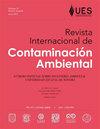Evaluation of manganese bioleaching and silver extraction in mining tailings by native bacteria using a flooded system
IF 0.4
4区 环境科学与生态学
Q4 ENVIRONMENTAL SCIENCES
引用次数: 0
Abstract
During the silver extraction process in mining, the generated residues (called tailings) still contain approximately 100-140 g/ton of silver due to the presence of refractory materials that trap this metal and prevent its solubilization by conventional methods. These residues can be treated by biohydrometallurgical processes allowing, together with the cyanidation process, an increase in the efficiency of silver extraction by eliminating refractory materials such as manganese, which is present as pyrolusite (MnO2, 3.78 %). Pyrolusite can change from manganese (IV) to manganese (II) when solubilized by bioleaching. This research analyzed the effects of bioleaching using native bacteria on the concentration of silver extraction from the removal of manganese in mining tailings. The native bacteria ITDBC2, ITDBC5, and ITDBC6 were identified as Leptospirillum ferriphilum by amplification of the 16S gene corroborated by bioinformatic analysis. The experimentation was carried out using a flooded bioleaching system (9.43 L) to resemble the industrial geometry with the following variables: concentration of ferrous ions (2, 7, and 14 g/L), pH (2, 4, and 6) and agitation time at 100 rpm (2, 4 and 6 min/day). The experimentation lasted 18 days. The removal of manganese and silver extraction was 71.84 and 55.53 %, respectively. The scaled-up of the evaluated bioprocess could reduce energy consumption and process larger amounts of pulp than the reported at the laboratory scale.水浸系统天然细菌浸出尾矿中锰和银的评价
在采矿中提取银的过程中,产生的残渣(称为尾矿)仍然含有大约100-140克/吨的银,因为存在耐火材料,这些耐火材料会捕获这种金属并阻止常规方法将其溶解。这些残留物可以通过生物湿法冶金工艺处理,与氰化工艺一起,通过去除难熔材料,如锰,提高银的提取效率,锰以软锰矿的形式存在(MnO2, 3.78%)。软锰矿经生物浸出可由锰(IV)转变为锰(II)。研究了利用天然细菌进行生物浸出对尾矿中锰的浸出银浓度的影响。经生物信息学分析证实,本地细菌ITDBC2、ITDBC5和ITDBC6为嗜铁钩端螺旋体。实验采用水淹式生物浸出系统(9.43 L),与工业几何形状相似,采用以下变量:亚铁离子浓度(2,7和14 g/L), pH值(2,4和6)以及100 rpm(2,4和6分钟/天)的搅拌时间。试验期18 d。锰和银的萃取去除率分别为71.84%和55.53%。所评估的生物工艺的扩大可以减少能源消耗,并处理比实验室规模报道的更多的纸浆。
本文章由计算机程序翻译,如有差异,请以英文原文为准。
求助全文
约1分钟内获得全文
求助全文
来源期刊

Revista Internacional De Contaminacion Ambiental
ENVIRONMENTAL SCIENCES-
CiteScore
0.90
自引率
16.70%
发文量
59
期刊介绍:
En esta revista se aceptan para su publicación trabajos originales y de revisión sobre aspectos físicos y químicos de la contaminación, investigaciones sobre la distribución y los efectos biológicos y ecológicos de los contaminantes; así como sobre tecnología e implementación de nuevas técnicas para su medida y control; también son aceptados estudios sociológicos, económicos y legales acerca del tema. Se publicarán los escritos que mediante arbitraje de especialistas y a juicio del Consejo Editorial tengan el nivel y la calidad adecuados para ello y su contenido será responsabilidad única de los autores. La Revista Internacional de Contaminación Ambiental es de periodicidad trimestral y se publica los días 1 de febrero, mayo, agosto y noviembre.
 求助内容:
求助内容: 应助结果提醒方式:
应助结果提醒方式:


